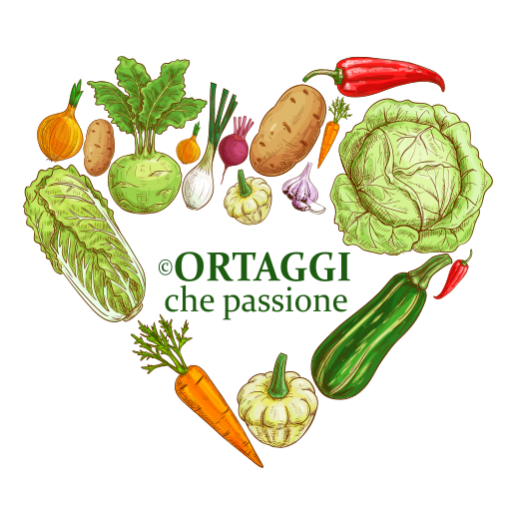Homemade wild violet syrup is quickly prepared, a day’s rest and this concentrated solution is ready. A sweet, colorful, and fragrant drink to dilute to taste with water, or use in cocktails, spritz, or add to tea (or herbal tea) instead of sugar. Violet syrup can be purchased at the supermarket or online, but it’s not the same as homemade. If you’re wondering how to use violets or what to do with violet flowers, read all my suggestions at the bottom.
“In our gardens, wild violets often grow with heart-shaped leaves. These delicate flowers are edible and have beneficial properties for our body. Their petals contain a high content of vitamin A and C, so much so that if petals are collected in the spring, these vitamins can be concentrated about twice as much as what is found in oranges or spinach. The flowers and leaves can be added to salads to give a touch of freshness, and many times they are also found in ointments for their antiseptic properties or in syrups thanks to their mucolytic action.” Dr. Lucchetti
Violet syrup is known for its potential benefits for the throat and congestion due to its soothing properties. It can help relieve throat irritation and reduce congestion thanks to its calming and refreshing action. Consumed in hot tea, it can offer relief.
VIOLET (viola odorata) SEASON – they bloom from late January to April.
RECIPES with Edible Flowers
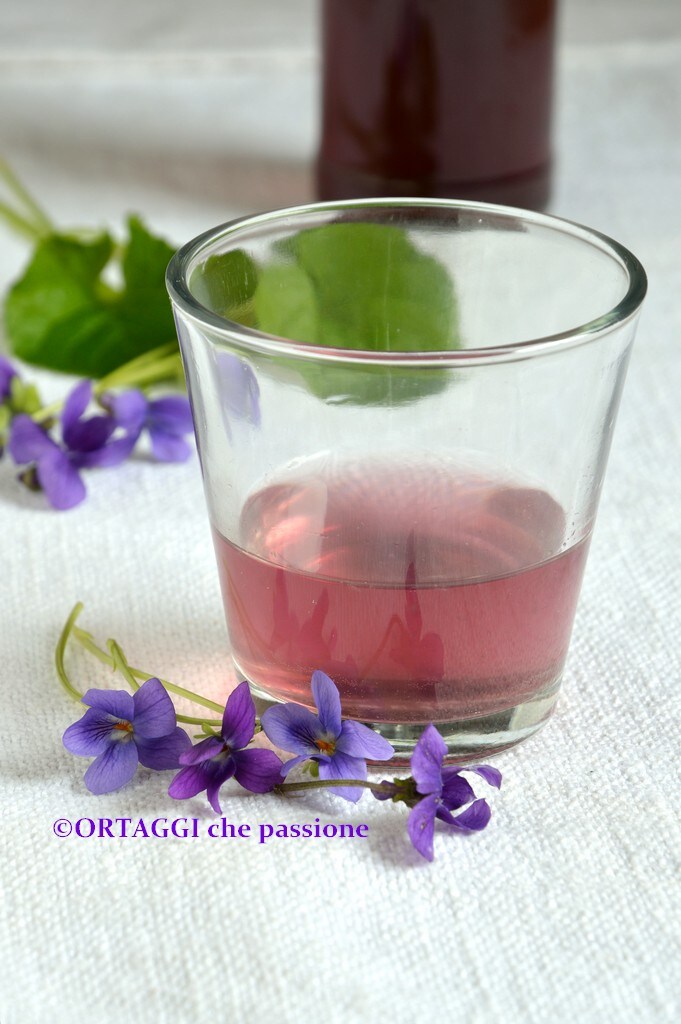
- Difficulty: Easy
- Cost: Economical
- Rest time: 1 Day
- Preparation time: 15 Minutes
- Cooking methods: Stovetop
- Cuisine: Wellness
- Seasonality: Winter, Spring
- Energy 177.38 (Kcal)
- Carbohydrates 46.91 (g) of which sugars 46.84 (g)
- Proteins 0.23 (g)
- Fat 0.06 (g) of which saturated 0.00 (g)of which unsaturated 0.00 (g)
- Fibers 0.00 (g)
- Sodium 3.21 (mg)
Indicative values for a portion of 100 g processed in an automated way starting from the nutritional information available on the CREA* and FoodData Central** databases. It is not food and / or nutritional advice.
* CREATES Food and Nutrition Research Center: https://www.crea.gov.it/alimenti-e-nutrizione https://www.alimentinutrizione.it ** U.S. Department of Agriculture, Agricultural Research Service. FoodData Central, 2019. https://fdc.nal.usda.gov
Violet Syrup
(about 150 grams of syrup)
- 0.7 oz violets
- 0.4 cup water
- to taste sugar (about 0.3 cups = 70% of the weight of the extracted liquid)
White sugar can be replaced with whole cane sugar (mascobado or muscovado), to add a molasses aroma to the preparation.
Tools
- Saucepan small
- Strainer fine mesh
- Funnel
- 1 Glass Bottle 150 ml
Violet Syrup
Collect violets in a non-polluted area, then wash them briefly and let them dry in a colander.
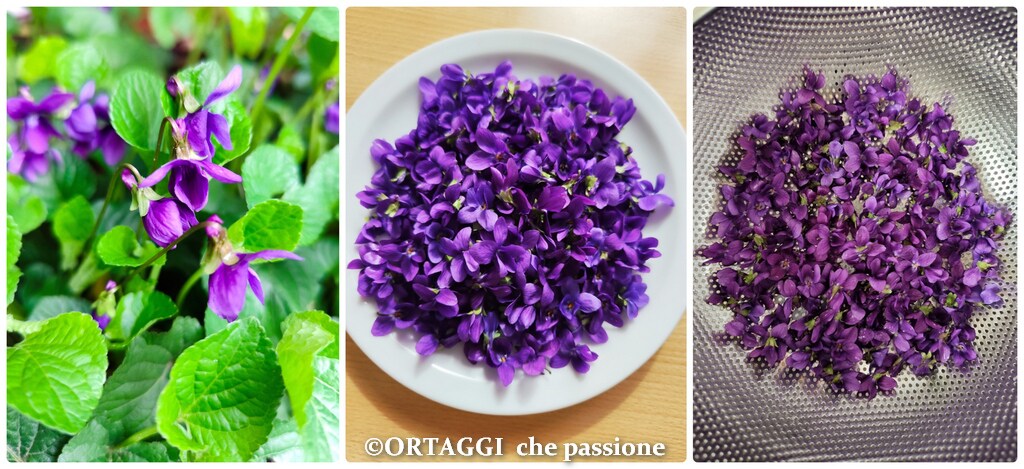
Place the dried violets in a jar or cup.
Then, bring the water to a boil in a small saucepan and pour it hot over the violets. Press them well into the liquid.
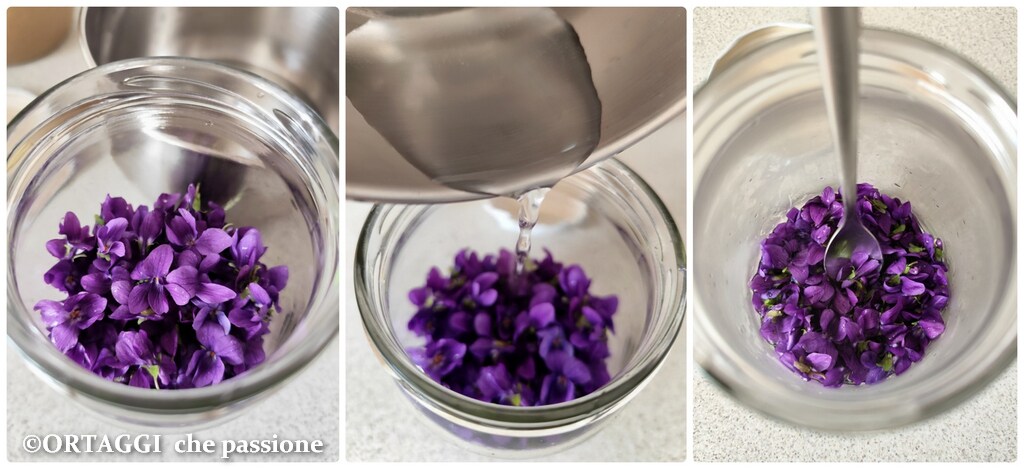
Cover with a cloth or lid (without sealing it) and place the violets in the refrigerator (or a cool place). Let them macerate for at least 1 day.
The next day, filter them with a fine mesh strainer and use a teaspoon to press out all the colored water. Weigh the obtained liquid and pour it into a small pan with the sugar (70% of the weight of the extracted liquid).
Then heat the colored water with the sugar over low heat, without boiling, just to dissolve the sugar completely.
To achieve a purple-pink hue like in the photo below, add a few drops of lemon (optional).

Turn off the heat and let the syrup cool completely before pouring it into the sterilized bottle. Ensure the preparation is at room temperature to avoid condensation inside the container. Then seal the bottle tightly.
Before pouring the syrup, sterilize the container and the lid.
How to STERILIZE:
– in the microwave: fill the bottles 3/4 with water and place them in the microwave for 3 minutes to boil the water inside, with the lids beside
– on the stovetop: immerse the containers and lids in boiling water for a few minutes
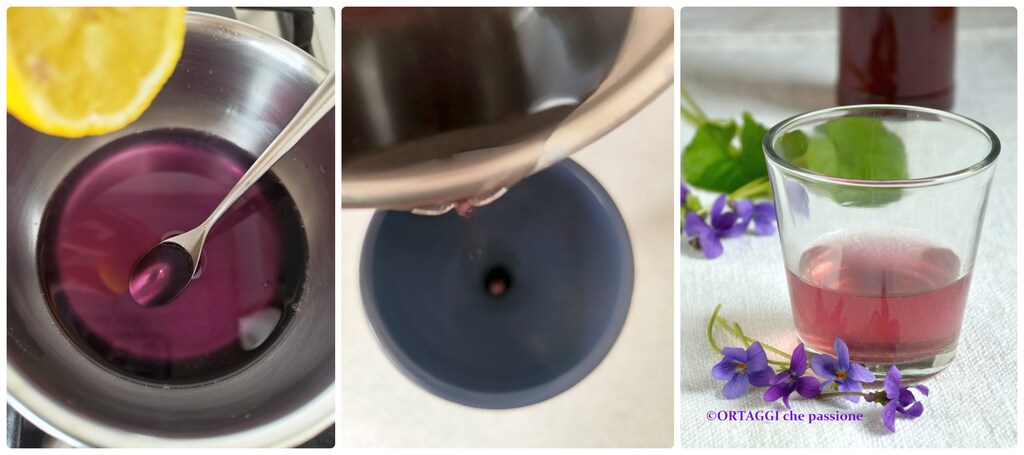
HOW TO CONSUME violet syrup?
Serve the syrup diluted with water to taste.
Add to tea or herbal tea.
Use it in cocktails, in a Champagne or Sparkling Wine flute, or in a Gin Tonic or spritz.
Storing Violet Syrup
To store violet syrup, pour it into a sterilized and tightly sealed container. Make sure it is completely cooled before sealing the container. If properly handled, it will keep for a year. Once opened, it should be stored in the refrigerator.
For extra assurance, keep it in the refrigerator and consume it within 20 days of first use.
How to Use Violet Syrup?
As a drink:
– dilute with water
– use in champagne or sparkling wine
– add to cocktails, spritz, gin tonic
As a sugar substitute:
– in tea, infusions, or herbal teas
– in desserts as a flavor
– for a sweet note in savory preparations
– for a sweet note in savory preparations
FAQ (Questions and Answers)
When to Pick Violets?
Violets are picked towards the end of winter and during spring, usually in March when they are in full bloom. Make sure to pick them in safe and unpolluted areas, preferably on a nice sunny day and during central hours.
How to Store Wild Violets?
Once picked, gently wash violets and let them air dry. Then, they can be dried or kept fresh in the refrigerator for up to a week.
How to Use Violets in Cooking?
You can enrich salads with petals or leaves of wild violets (wild or mammole) or use the flowers as decoration for cakes and ice creams. Try incorporating the petals or leaves into herbal teas or infusions. Alternatively, experiment by adding wild violets to vinegar, syrups, liqueurs, jams, marmalades, compotes, sweet creams, or sauces for a unique floral aroma. Crystallizing violet petals with sugar is a popular way to preserve them and use them as decoration.

